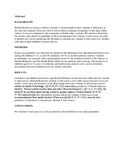Biofortified cassava with pro-vitamin A is sensory and culturally acceptable for consumption by primary school children in Kenya.

View/
Date
2013-08Author
Talsma, EF
Melse-Boonstra, A
de Kok, BP
Mbera, GN
Mwangi, AM
Brouwer, ID
Type
ArticleLanguage
enMetadata
Show full item recordAbstract
BACKGROUND:
Biofortification of cassava with pro-vitamin A can potentially reduce vitamin A deficiency in low-income countries. However, little is known about consumer acceptance of this deep yellow variety of cassava compared to the commonly available white varieties. We aimed to determine the sensory and cultural acceptability of the consumption of pro-vitamin A rich cassava in order to identify key factors predicting the intention to consume pro-vitamin A rich cassava by families with school-aged children in Eastern Kenya.
METHODS:
Sensory acceptability was measured by replicated discrimination tests and paired preference tests among 30 children (7-12 yr) and 30 caretakers (18-45 yr) in three primary schools. Cultural acceptability was assessed with a questionnaire based on the combined model of The Theory of Planned Behavior and The Health Belief Model in one primary school among 140 caretakers of children aged 6 to 12 years. Correlations and multivariate analyses were used to determine associations between summed scores for model constructs.
RESULTS:
Caretakers and children perceived a significant difference in taste between white and pro-vitamin A rich cassava. Both preferred pro-vitamin A rich cassava over white cassava because of its soft texture, sweet taste and attractive color. Knowledge about pro-vitamin A rich cassava and it's relation to health ('Knowledge' ((β = 0.29, P = <.01)) was a strong predictor of 'Health behavior identity'. Worries related to bitter taste and color ('Perceived barriers 1' (β = -0.21, P = .02)), the belief of the caretaker about having control to prepare cassava ('Control beliefs' (β = 0.18, P = .02)) and activities like information sessions about pro-vitamin A rich cassava and recommendations from health workers ('Cues to action'(β = 0.51, P = <.01)) were the best predictors of intention to consume pro-vitamin A rich cassava.
CONCLUSIONS:
Pro-vitamin A rich cassava is well accepted by school children in our study population.
Citation
PLoS One. 2013 Aug 30;8(8):e73433. doi: 10.1371/journal.pone.0073433.Publisher
Universty of Nairobi
